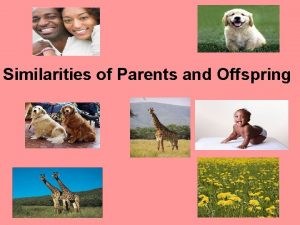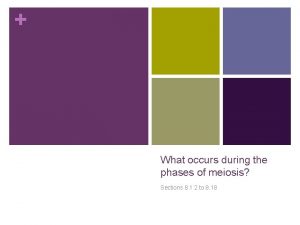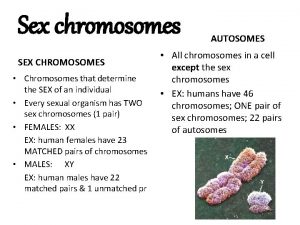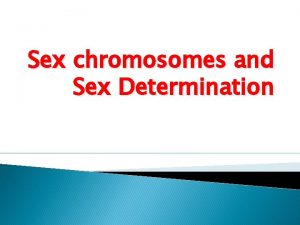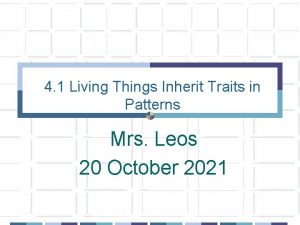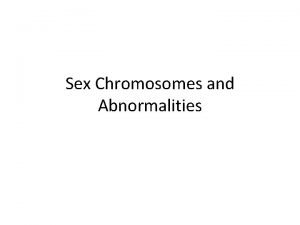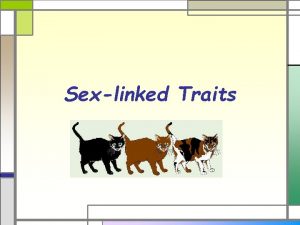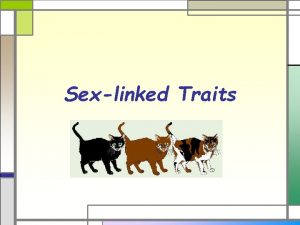Living Things Inherit Traits in Patterns Sex Chromosomes










- Slides: 10

Living Things Inherit Traits in Patterns.

Sex Chromosomes �Scientists refer to chromosomes by their number, 1 through 22. The 23 rd pair are the sex chromosomes. �In humans, the sex chromosomes are called the X chromosome and the Y chromosome. �A human female has two X chromosomes. (XX) �A human male has one X chromosome and one Y chromosome. (XY) �These chromosomes determine the sex of the offspring, as well as contain important genes like the other numbered 1 -22 chromosomes.

Patterns of heredity can be predicted. �Mendel noticed traits are inherited in patterns. A tool for understanding the patterns of heredity is called a Punnett Square. �Each parent has two alleles for a specific gene. A Punnett Square shows how the parents’ alleles may be passed on to potential offspring. �Dominant alleles are expressed in a capital letter. Ex: “D” �Recessive alleles are expressed in a lower-case letter. Ex: “d” �Example problem: DD x dd

Punnett Squares D d d D • Parent 1 Tree has a genotype of DD • Parent 2 Tree has a genotype of dd

Ratios and percentages can express the probability of outcomes. �Our Punnett Square example shows an outcome of 100% regular height, because we had four combinations: Dd, Dd, Dd. These combinations all had one dominant allele, and the dominant allele (D) wins over the recessive allele (d). So all four offspring will be regular height. �Heterozygous – two different alleles are expressed in the offspring �Ex: Dd �Homozygous – both alleles are the same �Homozygous dominant: both alleles are dominant (DD) �Homozygous recessive: both alleles are recessive (dd)

Ratio �Let’s look at our example. There is a 100% chance that the offspring plant will be regular height, right? �A ratio compares or shows the relationship between two quantities. �The ratio in this case is written as 4: 4 (“four to four”, and can be interpreted as “four out of 4”) D D Dd Dd d Dominant squares are hilighted in red. There is a 4: 4 ratio of red squares to total squares.

Probability �Punnett Squares and the ratios they show express probability. �Probability is the likelihood (or chance) of a specific outcome in relation to the total number of possible outcomes. �The ratios we get from a Punnett Square tell us the probability that any one offspring will get certain genes and express certain traits. �The other way to express a probability is as a percentage. �A percentage is a ratio that compares a number to 100. �It states the number of times out of a hundred a particular outcome might happen.

Guinea pigs and fur color… B B b b B = black fur b = brown fur What is the probability that the offspring will be brown? Black?

Probability �When one parent has two dominant alleles and one parent has two recessive alleles, there is a 100% chance that an offspring will have the dominant phenotype. �When both parents have one dominant and one recessive allele, there is a 75% chance that an offspring will have the dominant phenotype. �It’s important to note that probability and Punnett Squares do not guarantee the outcome, but are just an estimate of probability.

Gender probability X X Y X What is the probability that the offspring will be male? Female?





